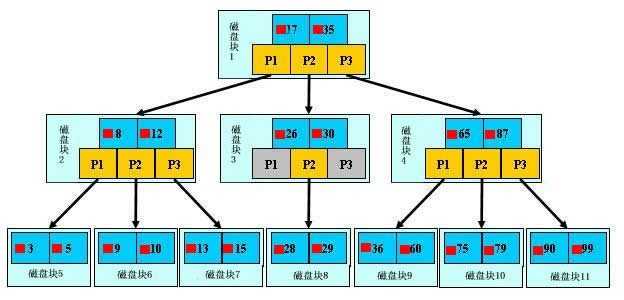标签:条件查询 arc 磁盘 debug desc ble esc log blog
索引的目的在于提高查询效率,如字典,查询一个单词,需要定位到首字母,然后定位第二个字母,依次来查询。如果没有索引,就需要把字典中的单词看一遍,才能找到想要的单词。
1.b+树:

浅蓝色的块我们称之为一个磁盘块,可以看到每个磁盘块包含几个数据项(深蓝色所示)和指针(黄色所示),如磁盘块1包含数据项17和35,包含指针P1、P2、P3,P1表示小于17的磁盘块,P2表示在17和35之间的磁盘块,P3表示大于35的磁盘块。真实的数据存在于叶子节点即3、5、9、10、13、15、28、29、36、60、75、79、90、99。非叶子节点不存储真实的数据,只存储指引搜索方向的数据项,如17、35并不真实存在于数据表中。
2.b+树查找过程
如图所示,如果要查找数据项29,那么首先会把磁盘块1由磁盘加载到内存,此时发生一次IO,在内存中用二分查找确定29在17和35之间,锁定磁盘块1的P2指针,内存时间因为非常短(相比磁盘的IO)可以忽略不计,通过磁盘块1的P2指针的磁盘地址把磁盘块3由磁盘加载到内存,发生第二次IO,29在26和30之间,锁定磁盘块3的P2指针,通过指针加载磁盘块8到内存,发生第三次IO,同时内存中做二分查找找到29,结束查询,总计三次IO。真实的情况是,3层的b+树可以表示上百万的数据,如果上百万的数据查找只需要三次IO,性能提高将是巨大的,如果没有索引,每个数据项都要发生一次IO,那么总共需要百万次的IO,显然成本非常非常高。
1.普通索引
功能:加速查找

CREATE TABLE tb2( nid INT NOT NULL auto_increment PRIMARY KEY, name VARCHAR(32) NOT NULL, email VARCHAR(64) NOT NULL, extra text, INDEX ix_name(name) )ENGINE=INNODB DEFAULT charset=‘utf8‘;

CREATE INDEX index_name ON table_name(colunm_name)

DROP INDEX index_name ON table_name

SHOW INDEX FROM table_name
注意:创建索引时,如果字段为BLOB和text类型,必须指定length。
2.唯一索引
功能:加速查询、唯一约束(可以为null)

CREATE TABLE tb2( nid INT NOT NULL auto_increment PRIMARY KEY, name VARCHAR(32) NOT NULL, email VARCHAR(64) NOT NULL, extra text, UNIQUE ix_name(name) )ENGINE=INNODB DEFAULT charset=‘utf8‘;

CREATE UNIQUE index_name ON table_name(colunm_name)

DROP UNIQUE index_name ON table_name
3.主键索引
功能:加速查询、唯一约束(不可以为null)

CREATE TABLE tb2( nid INT NOT NULL auto_increment PRIMARY KEY, name VARCHAR(32) NOT NULL, email VARCHAR(64) NOT NULL, extra text )ENGINE=INNODB DEFAULT charset=‘utf8‘;
or

CREATE TABLE tb2( nid INT NOT NULL auto_increment, name VARCHAR(32) NOT NULL, email VARCHAR(64) NOT NULL, extra text, PRIMARY KEY(nid) )ENGINE=INNODB DEFAULT charset=‘utf8‘;
注:主键时一种特殊的索引,设置主键即创建了该字段的索引。

ALTER TABLE table_name ADD PRIMARY KEY(colunm_name)

ALTER TABLE table_name DROP PRIMARY KEY ALTER TABLE table_name MODIFY colunm_name type,DROP PRIMARY KEY
4.组合索引
组合索引是指,将多个列组合成一个索引。
场景:频繁地同时使用多个列进行查询。

CREATE INDEX ix_account_email ON user(account,email)
组合索引最左匹配:
创建组合索引后,执行查询:
select * from user where account=‘oliver‘; #走索引 select * from user where account=‘oliver‘ and email=‘asdfaskl@163.com‘; #走索引 select * from user where email=‘asdfaskl@163.com‘; #不走索引
5.全文索引
对文本的内容进行分词,进行搜索
6.索引合并
使用多个单列索引组合搜索。如下:
nid name(单独索引) email(单独索引) pwd
select * from tb where name=‘alex‘ select * from tb where email=‘alex3714@163.com‘ select * from tb where name=‘alex‘ or email=‘alex3714@163.com‘
7.覆盖索引
只需要从索引中查询就能得到结果,不必再去读取数据表。
例:
select * from tb where nid=1 # 先从索引表中找,再去数据表中找,非覆盖索引
select nid from tb where nid < 10 # 只需要从索引表中找,就能得到查询结果。 覆盖索引。
用于显示sql执行信息,相对比较准确表达出当前SQL运行状况,用户可以参考执行信息对sql语句进行优化。
格式: explain SQL语句
mysql> explain select * from user where email=‘oliver@163.com‘; +----+-------------+-------+------------+------+---------------+------+---------+------+--------+----------+-------------+ | id | select_type | table | partitions | type | possible_keys | key | key_len | ref | rows | filtered | Extra | +----+-------------+-------+------------+------+---------------+------+---------+------+--------+----------+-------------+ | 1 | SIMPLE | user | NULL | ALL | NULL | NULL | NULL | NULL | 261791 | 10.00 | Using where | +----+-------------+-------+------------+------+---------------+------+---------+------+--------+----------+-------------+ 1 row in set, 1 warning (0.00 sec)
1.id:查询顺序标识
2.select_type:查询类型
3.table:查询的表
4.type:查询时的访问方式
查询时的访问方式,性能:all < index < range < index_merge < ref_or_null < ref < eq_ref < system/const
(1)ALL 全表扫描
遍历整个数据表,如果有limit时,找到结果后就不再往下找了。
(2)INDEX 全索引表扫描
(3)RANGE 对索引列进行范围查找
mysql> explain select uid from user where uid<10200; +----+-------------+-------+------------+-------+---------------+---------+---------+------+-------+----------+--------------------------+ | id | select_type | table | partitions | type | possible_keys | key | key_len | ref | rows | filtered | Extra | +----+-------------+-------+------------+-------+---------------+---------+---------+------+-------+----------+--------------------------+ | 1 | SIMPLE | user | NULL | range | PRIMARY | PRIMARY | 4 | NULL | 11622 | 100.00 | Using where; Using index | +----+-------------+-------+------------+-------+---------------+---------+---------+------+-------+----------+--------------------------+ 1 row in set, 1 warning (0.00 sec)
(4)INDEX_MERGE 合并索引,使用多个单列索引搜索
(5)REF 根据索引查找一个或多个值
(6)EQ_REF 连接表时,使用primary key 或 unique类型字段
(7)CONST 常量,表中最多有一个匹配行
mysql> explain select uid from user where uid=10200; +----+-------------+-------+------------+-------+---------------+---------+---------+-------+------+----------+-------------+ | id | select_type | table | partitions | type | possible_keys | key | key_len | ref | rows | filtered | Extra | +----+-------------+-------+------------+-------+---------------+---------+---------+-------+------+----------+-------------+ | 1 | SIMPLE | user | NULL | const | PRIMARY | PRIMARY | 4 | const | 1 | 100.00 | Using index | +----+-------------+-------+------------+-------+---------------+---------+---------+-------+------+----------+-------------+ 1 row in set, 1 warning (0.00 sec)
(8)SYSTEM 系统
表仅有一行(=系统表)。这是const联接类型的一个特例。
select * from (select nid from tb1 where nid = 1) as A;
5.possible_keys
可能使用的索引
6.key
真实使用的索引
7.key_len
MySQL中使用索引字节长度
8.rows
mysql估计为了找到所需的行而要读取的行数 ------ 只是预估值
9.Extra
该列包含MySQL解决查询的详细信息
要使用正确的方式命中索引。如果方式错误,即使建立了索引也无法命中。
- like ‘%xx‘ select * from tb1 where name like ‘%cn‘; - 使用函数 select * from tb1 where reverse(name) = ‘wupeiqi‘; - or select * from tb1 where nid = 1 or email = ‘seven@live.com‘; # nid有索引,email未创建索引,则不能命中索引 特别的:当or条件中有未建立索引的列才失效,以下会走索引 select * from tb1 where nid = 1 or name = ‘seven‘; #nid和name都创建了索引,能命中索引 select * from tb1 where nid = 1 or email = ‘seven@live.com‘ and name = ‘alex‘ - 类型不一致 如果列是字符串类型,传入条件是必须用引号引起来,不然... select * from tb1 where name = 999; - != select * from tb1 where name != ‘alex‘ 特别的:如果是主键,则还是会走索引 select * from tb1 where nid != 123 - > select * from tb1 where name > ‘alex‘ 特别的:如果是主键或索引是整数类型,则还是会走索引 select * from tb1 where nid > 123 select * from tb1 where num > 123 - order by select email from tb1 order by name desc; 当没有where条件时,order by主键则走索引,有where时,order by索引字段则走索引。 特别的:如果对主键排序,则还是走索引: select * from tb1 order by nid desc; - 组合索引最左前缀 如果组合索引为:(name,email) name and email -- 使用索引 name -- 使用索引 email -- 不使用索引
避免使用select * - count(1)或count(列) 代替 count(*) - 创建表时尽量时 char 代替 varchar - 表的字段顺序固定长度的字段优先 - 组合索引代替多个单列索引(经常使用多个条件查询时) - 尽量使用短索引 - 使用连接(JOIN)来代替子查询(Sub-Queries) - 连表时注意条件类型需一致 - 索引散列值(重复少)不适合建索引,例:性别不适合
1.配置MySQL自动配置慢日志
slow_query_log = OFF 是否开启慢日志记录 long_query_time = 2 时间限制,超过此时间,则记录 slow_query_log_file = /usr/slow.log 日志文件 log_queries_not_using_indexes = OFF 为使用索引的搜索是否记录
注:查看当前配置信息:
show variables like ‘%query%‘
修改当前配置:
set global 变量名 = 值
2.查看MySQL慢日志
mysqldumpslow -s at -a /usr/local/var/mysql/MacBook-Pro-3-slow.log
""" --verbose 版本 --debug 调试 --help 帮助 -v 版本 -d 调试模式 -s ORDER 排序方式 what to sort by (al, at, ar, c, l, r, t), ‘at‘ is default al: average lock time ar: average rows sent at: average query time c: count l: lock time r: rows sent t: query time -r 反转顺序,默认文件倒序拍。reverse the sort order (largest last instead of first) -t NUM 显示前N条just show the top n queries -a 不要将SQL中数字转换成N,字符串转换成S。don‘t abstract all numbers to N and strings to ‘S‘ -n NUM abstract numbers with at least n digits within names -g PATTERN 正则匹配;grep: only consider stmts that include this string -h HOSTNAME mysql机器名或者IP;hostname of db server for *-slow.log filename (can be wildcard), default is ‘*‘, i.e. match all -i NAME name of server instance (if using mysql.server startup script) -l 总时间中不减去锁定时间;don‘t subtract lock time from total time """
标签:条件查询 arc 磁盘 debug desc ble esc log blog
原文地址:http://www.cnblogs.com/pyramid1001/p/6003128.html